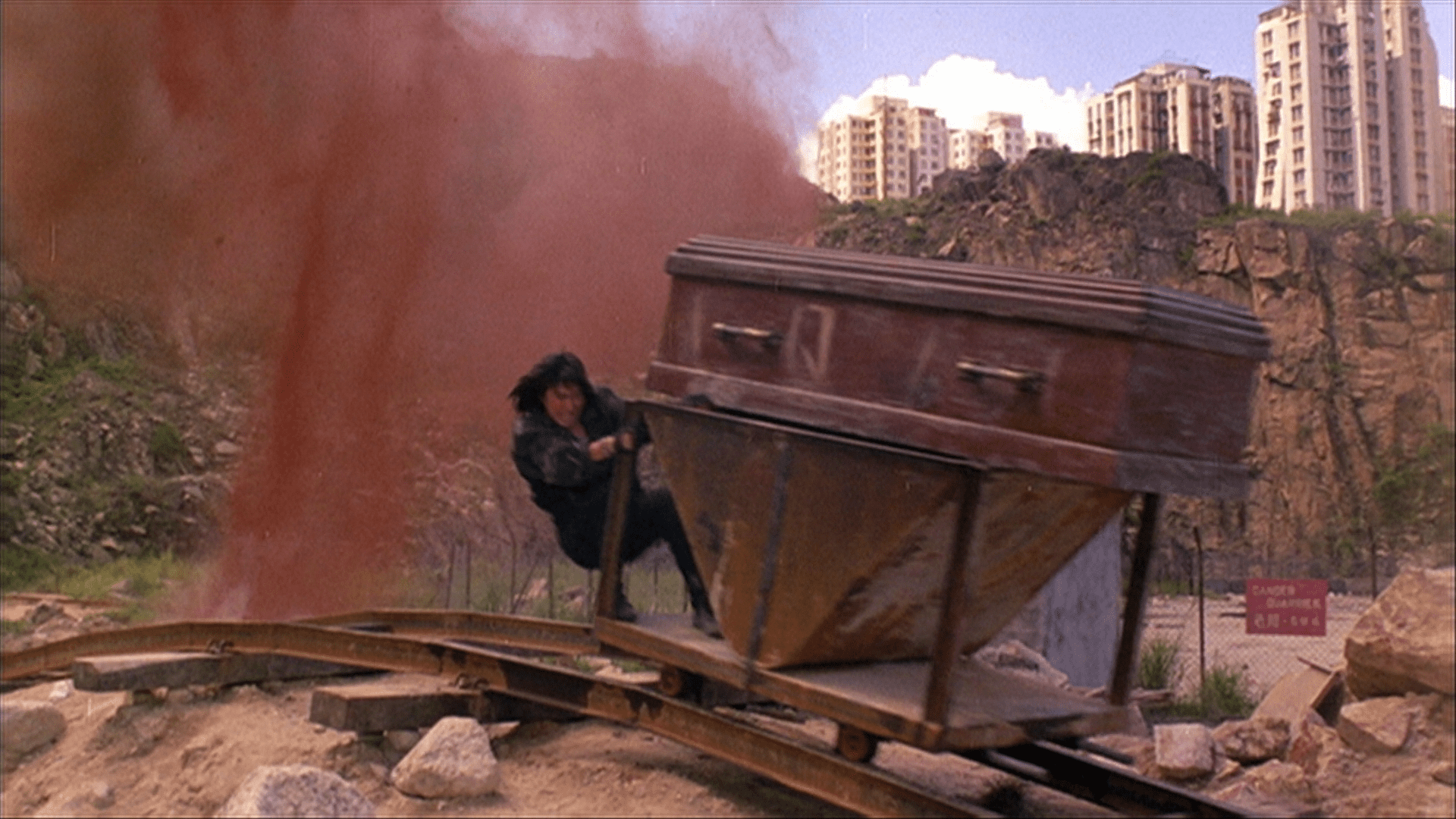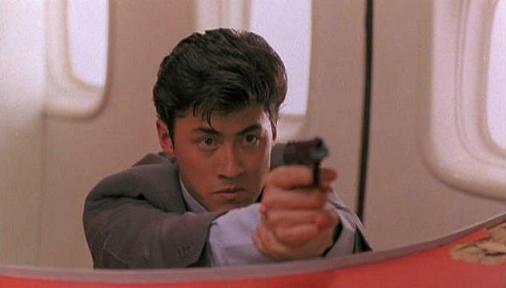Hong Kong action movies are like Bollywood movies: cinematic adrenaline. They have a refreshing love of movement and style that so many American blockbusters either detest or shy away from for fear of being noticed. As if a movie has style or tone is a detriment.
David Chung’s Royal Warriors is a 1986 Hong Kong action movie that the trailers would describe as “high octane” or “explosive.” But, in many ways, Royal Warriors is a perfect example of the style Hong Kong action movies perfected. The blending of soap-opera-esque melodrama with action set pieces that leave you questioning whether all the stunt people made it out alive.

In addition, the 1986 movie is the first in a series of films known as the In the Line of Duty franchise. The sequel is Corey Yeun’s 1985 iconic In the Line of Fire II: Police Assasians, or as it’s known by its other title, Yes, Madam!; the movie that launched the careers of Michelle Yeoh and Cynthia Rothrock and gave birth to the “girls with guns” action sub-genre. Ironic considering that while the two leads both have guns, the final fifteen-minute-long fight is mostly martial arts.
The In the Line of Duty series is a reminder that the studio’s greed knows no bounds or logic. Yes, Madam! came out a year before but was exported after Royal Warriors, and thus the name changed to boost ticket sales despite the only common theme of either movie being Michelle Yeoh–or as she was going by at that time Michelle Kahn. In the Line of Duty III and In the Line of Duty IV followed, starring Cynthia Kahn, and much like their predecessors, had nothing to do with each other.
In Royal Warriors, Yeoh is once again a police inspector, Michelle Yip. Only this time, she finds herself the target of revenge after she helped stop a prison break turned hijacking with Interpol agent Peter Yamamoto (Hiroyuki Sanada) and air marshall Michael Wong played by Micahel Wong. The three successfully foil the escape attempt and soon find themselves being hunted by the surviving members of the gang.
Chung’s directorial style contrasts Yeun’s in that Chung is a cinematographer turned director. The narrative of Royal Warriors is perpetually in motion through images and sound. A phone ringing, for example, will be Chung’s way of transitioning from scene to scene. Flashbacks are shown with a blue tint, reminiscent of the silent film era when they used to color tinted scenes.
In addition, Chung and his camerapeople, Derek Wan and Ma Chun-Wah, frame the action in long takes instead of Yeun’s staccato editing style. As a result, we are allowed to see multiple hits before a cut. But Chung and his team also infuse a brutal, almost horror aspect to Royal Warriors. For example, one scene on the plane has Hing Yin-Kam, the hijacker, breaking one of the plane’s windows with a fire extinguisher. Eventually, his head gets sucked through the window, his corpse looking like something from a Hammer or a Shaw Brothers horror film.

At the same time, there’s a sense of playfulness about Chung’s Royal Warriors. Fights aboard airplanes leave us gasping that we’re fighting here, mixed with long panning shots of a nightclub that have us grinning because we know that we are most definitely having a fight scene here. Not to mention sly references to Hiroshi Teshigahara’s 1964 Woman in the Dunes, with a finale so bonkers that Tango & Cash likely aped most of it for its own ending.
In many respects, Royal Warriors is an action movie turned up to eleven for its entire runtime. But Chung and his camera team do a deft job of moving the story along so that it never drags. For every over-the-top melodramatic moment, such as Sanada’s Peter watching his wife and daughter die in a fiery explosion with Chung zooming in on his daughter’s teddy bear, an action scene follows it that matches its intensity.
Kan-Cheung Tsang’s script doesn’t dally by wallowing in misery, either. There’s a lot of personal tragedy, but we don’t see characters falling to pieces and delivering monologues. This is not to say feelings aren’t explored; merely that Kan-Cheung and Chung use stoicism to enhance the operatic intensity of it all. Royal Warriors is a movie with such over-the-top action and drama that the only way to play it is just this side of serious but not too serious. A balancing act that Chung and his team pull off spectacularly.
Royal Warriors glides along almost in a dreamscape. It feels lush and intense in a way that only a movie or a dream can be. Part of this stems from how almost everyone was dubbed in Cantonese. Michael Wong delivered much of his dialogue in English, Yeoh spoke Mandarin, and Hiroyuki Sanada spoke, of course, Japanese. It heightens artificiality and explains the terse dialogue in Kan-Cheung’s script to cut down on the needed ADR. Still, it’s not like the characters are minimalists; Wong and Yeoh have reems of banter as Wong attempts to woo her. Though being the 1980s, Wong’s attempts at flirting seem more like stalking. But Yeoh is so clearly playing hard to get, and Wong is so damn charming that it isn’t so nearly as slimy as it could be.
If Yes, Madam! Catapulted Yoh into stardom, Royal Warriors cements her status as a superstar. Her dance background gives her graceful, fluid movements in the fight scenes.
Despite being a co-lead, Yeohs steals the show. Her Yip is coy, flirtatious, hard-nosed, and defiant. When she first meets Wong, he begins to brag about being the federal marshall, unaware that she’s a policewoman, and she plays along—egging him and playing the wide-eyed innocent. In a way, she’s playing both the heroine and the romantic lead, as while she’s always lecturing Wong, she always smiles dreamily whenever he appears.

Royal Warriors leaps from improbable action set piece to fantastical action set piece leaving us gobsmacked every step of the way. It contains two of the most bizarre instances of someone holding another hostage I’ve ever seen. One ending in suicide and the other involving his corpse. In the middle of all this is a car chase scene from legendary stunt driver Blackie Shou-Liang Ko that has cars using car wrecks as ramps and buses leaping through the air almost a decade before Speed.
Chung and Kwok-Keun Cheung edit the chase sequence with a breathless vitality. It pulls you in and drags you along the concrete as Chung and Kwok-Keun immerse us in Shou-Liang’s metallic ballet of screeching rubber and clashing steel.
Royal Warriors is an action movie that understands that action is movement; in cinema, movement is life. Chung infuses a breathlessness into the pacing, constantly using imagery and cuts to propel the narrative forward. By the end, you’re left spent and elated as you realize, yes, that all just really happened, and it was glorious.
Images courtesy of 88 Films
Have strong thoughts about this piece you need to share? Or maybe there’s something else on your mind you’re wanting to talk about with fellow Fandomentals? Head on over to our Community server to join in the conversation!

